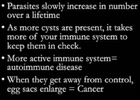Parasite: An organism that lives in, and at the expense of another organism. This encompasses the flukes, worms, bacteria, microbes and viruses.
I have always viewed parasites as a blight and a scourge upon our 3D planet, where 'feeding' is prevalent.
I have been reading a very enlightening and scary book about parasites; it is Parasite Rex by Carl Zimmer.
He talks about how parasites can alter the behaviour of a host in one phase of their life cycle so that a new host can be found for the their next phase. This can mean affecting their brains so that a fear of predators is minimized, or even altering their mating preferences so that a mate of suitable 'genetic infection' can be found to further the parasite's development.
One example that he describes is the fluke parasite called Euhaplorchis californiensis in the Carpenteria salt marsh. Birds release the parasite's eggs in their droppings, which are then consumed by horn snails. The eggs hatch then castrate the snail, and spend a couple of generations there before the cercariae emerge from the snail to then search out and lodge into the California killifish. There they follow a nerve to the brain and create a coating over the brain that makes the fish more desireable prey for the shore birds. Once in the bird's guts, the eggs are layed and the cycle starts over again. Upon more detailed research by Kevin Lafferty, it was discovered that the infected killifish would swim much nearer the pond surface and flash their underbellies much more frequently (gaining predator attention) than the uninfected fish. In fact, after comparing the flashing rates he discovered that the infected killifish flash rate was 30 times the rate of the uninfected killifish. That means that the predator populations would be greatly reduced if they had to depend solely on uninfected killifish!!
It's common thinking that predators keep the prey population in check, but is that really the case? The wolf is the host of a tapeworm Echinococcus granulosus (up to 6 mm length) where it is quite benign, but it lays its eggs there that are then deposited into grasses by the wolf. The eggs are consumed by moose who graze the grasses and once inside the moose, they develop into cysts which house about 30 individuals. These tapeworms will continue to grow if there is no bone in the way (in humans they have been known to grow so large that they contain 15 quarts of fluid and millions of tapeworms), and one of their favorite locations to grow is in the lungs. In the moose, the bronchial tubes are torn and blood vessels broken and the moose is weakened so that when the wolves attack they will focus on the old or weakened moose as their prey, and hence the parasite's cycle repeats itself.
Carl Zimmer highlights this fact that parasites are major factors in our predator/prey ecological cycles, but he goes further to show that as a host will defend itself over time by changing its eating habits to avoid foods that the parasite like, so too, the parasite will try to adapt to a new food source in the host. This 'catch me if you can' process becomes a major driver of evolution and it doesn't always happen slowly, but can alter quite quickly as some of these adaptations involve turning off or on certain genes to effect the change.
Here is a quote that has an interesting twist:
Helminthic therapy is the term given to medical treatment of disease through the re-introduction of a helminth parasite. Google Jasper Lawrence for his story.
Since parasites
- are the norm for all species
- are a driver of our predator/prey ecology
- are likely deeply connected to our evolution
- can act as partners where both host and parasite benefit
- can turn on/off genes to alter host behaviours
- have access to knowledge of their host's brain and body structures
- have access to knowledge of their hosts predators and their structures and habits
could they be a 4D and/or 6D projection into 3D?
Yes, learning can be fun.
I have always viewed parasites as a blight and a scourge upon our 3D planet, where 'feeding' is prevalent.
I have been reading a very enlightening and scary book about parasites; it is Parasite Rex by Carl Zimmer.
He talks about how parasites can alter the behaviour of a host in one phase of their life cycle so that a new host can be found for the their next phase. This can mean affecting their brains so that a fear of predators is minimized, or even altering their mating preferences so that a mate of suitable 'genetic infection' can be found to further the parasite's development.
One example that he describes is the fluke parasite called Euhaplorchis californiensis in the Carpenteria salt marsh. Birds release the parasite's eggs in their droppings, which are then consumed by horn snails. The eggs hatch then castrate the snail, and spend a couple of generations there before the cercariae emerge from the snail to then search out and lodge into the California killifish. There they follow a nerve to the brain and create a coating over the brain that makes the fish more desireable prey for the shore birds. Once in the bird's guts, the eggs are layed and the cycle starts over again. Upon more detailed research by Kevin Lafferty, it was discovered that the infected killifish would swim much nearer the pond surface and flash their underbellies much more frequently (gaining predator attention) than the uninfected fish. In fact, after comparing the flashing rates he discovered that the infected killifish flash rate was 30 times the rate of the uninfected killifish. That means that the predator populations would be greatly reduced if they had to depend solely on uninfected killifish!!
It's common thinking that predators keep the prey population in check, but is that really the case? The wolf is the host of a tapeworm Echinococcus granulosus (up to 6 mm length) where it is quite benign, but it lays its eggs there that are then deposited into grasses by the wolf. The eggs are consumed by moose who graze the grasses and once inside the moose, they develop into cysts which house about 30 individuals. These tapeworms will continue to grow if there is no bone in the way (in humans they have been known to grow so large that they contain 15 quarts of fluid and millions of tapeworms), and one of their favorite locations to grow is in the lungs. In the moose, the bronchial tubes are torn and blood vessels broken and the moose is weakened so that when the wolves attack they will focus on the old or weakened moose as their prey, and hence the parasite's cycle repeats itself.
Carl Zimmer highlights this fact that parasites are major factors in our predator/prey ecological cycles, but he goes further to show that as a host will defend itself over time by changing its eating habits to avoid foods that the parasite like, so too, the parasite will try to adapt to a new food source in the host. This 'catch me if you can' process becomes a major driver of evolution and it doesn't always happen slowly, but can alter quite quickly as some of these adaptations involve turning off or on certain genes to effect the change.
Here is a quote that has an interesting twist:
Intestinal parasites are still common in most of the world, but in countries where they've been eradicated, colitis and Chrohn's disease have followed fast. Humans may have been protected from diseases like these by the interplay between their immune systems and intestinal parasites.
...
In 1997, scientists at the University of Iowa put this idea into startling practise. they picked seven people with Ulcerative Colitis and Chrone's disease who had gotten no relief from any conventional treatment. They fed them eggs from an intestinal parasite that normally lives in an animal, one that wouldn't cause any disease of its own in a human gut (the scientists are still keeping the species a secret until they've finished their research). Within a couple of weeks the eggs had hatched, the larvae had grown, and six out of seven people went into complete remission.
Parasite-free living may also be responsible for the rise of other immune disorders, such as allergies. Twenty percent of the population of the industrial world suffer from allergies, but elsewhere they're hard to find. Snce it is dangerous to generalize from country to country, an immunologist Neil Lynch has done fine-grained studies of this pattern in Venezuela. He looked at people in upper-class homes with running water and toilets, compared them with poor Venezuelans in slums. While 43% of upper-class people had allergies, only 10% had light infections from intestinal worms. Among the poor, there were half these allergies as in the upper-classes but twice the worms. And when Lynch studied Venezuelan Indians who live in rain forests, the pattern was even starker: 88% were infected with parasites and they had no allergies at all.
Without parasitic worms exerting their influence, our immune systems may be prone to overreacting to harmless bits of cat dander and mold.
Helminthic therapy is the term given to medical treatment of disease through the re-introduction of a helminth parasite. Google Jasper Lawrence for his story.
Since parasites
- are the norm for all species
- are a driver of our predator/prey ecology
- are likely deeply connected to our evolution
- can act as partners where both host and parasite benefit
- can turn on/off genes to alter host behaviours
- have access to knowledge of their host's brain and body structures
- have access to knowledge of their hosts predators and their structures and habits
could they be a 4D and/or 6D projection into 3D?
Yes, learning can be fun.


